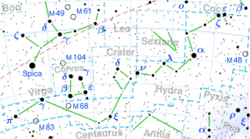Astronomy:Sigma Hydrids
From HandWiki
Short description: Meteor shower
| Sigma Hydrids | |
|---|---|
 Celestial map of Hydra | |
| Parent body | Unknown C/2023 P1 (Nishimura)? |
| Radiant | |
| Constellation | Hydra |
| Right ascension | 8h 19m 60s |
| Declination | +02° 00′ 00″ |
| Properties | |
| Occurs during | November 22 to January 4[1] |
| Date of peak | December 7 |
| Velocity | 58.8[1] km/s |
| Zenithal hourly rate | 3-7 |
Sigma Hydrids are a faint, minor (Class II) meteor shower that peak around 7 December. The ZHR is 3-7 and population index is 3. They are active from November 22 to January 4.[1]
Sigma hydrids were discovered by Richard E. McCrosky and Annette Posen.[2]
2023
Long-period comet C/2023 P1 (Nishimura) has been suggested to be the parent body of the meteor shower and came to perihelion (closest approach to the Sun) in September 2023. There is a chance of increased activity during the 2023 meteor shower if Earth passes through older meteoroid streams (such as 1591)[3] that have had time to spread out over the comets orbit.[4]
References
- ↑ Jump up to: 1.0 1.1 1.2 "2023 Meteor Shower List". American Meteor Society (AMS). https://www.amsmeteors.org/meteor-showers/2020-meteor-shower-list/. Retrieved 2023-09-10.
- ↑ [1] archive:[2]
- ↑ Tp = 2302476.6 converts to 1591.
- ↑ Green, Daniel. "Electronic Telegram No. 5290: COMET C/2023 P1 (NISHIMURA)". Harvard University. http://www.cbat.eps.harvard.edu/iau/cbet/005200/CBET005290.txt.
- P. Clay Sherrod; Thomas L. Koed (2012). A Complete Manual of Amateur Astronomy: Tools and Techniques for Astronomical Observations. Courier Corporation. p. 59. ISBN 978-0-486-15216-5. https://books.google.com/books?id=CjTDAgAAQBAJ&pg=PT100.
 |

